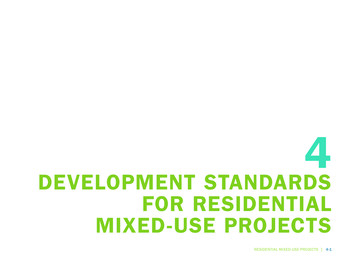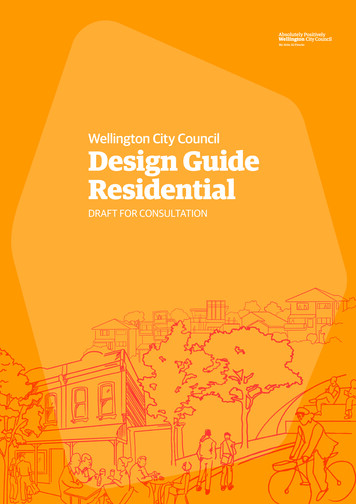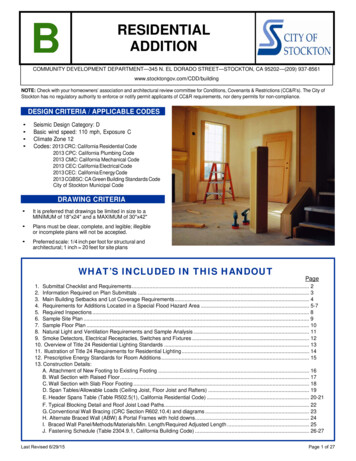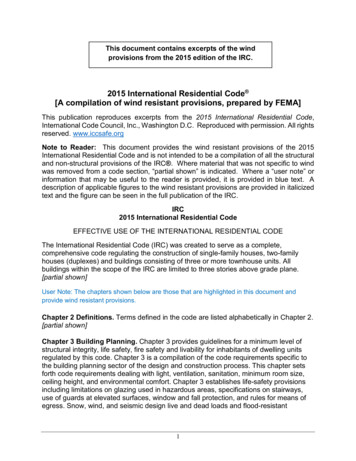
Transcription
4DEVELOPMENT STANDARDSFOR RESIDENTIALMIXED-USE PROJECTSRESIDENTIAL MIXED-USE PROJECTS 4-1
This chapter presents standards for residential mixed-use projects in the Ashland and Cherryland Business Districtand the Castro Valley Central Business District. Although there are several different types of mixed-use development, this chapter only addresses mixed-use development that includes residential uses. Section 4.1 discusses thevarious districts in the unincorporated areas of West Alameda County in which residential mixed-use projects areallowed. Section 4.2 shows drawings to provide a summary of the major development standards in a visual format,followed by a table listing all the development standards. Standards in bold italics are existing County standards.This Chapter is organized by the following sections.4.1 Residential Mixed-Use: Appropriate Zones and Densities4.2 Residential Mixed-Use Standards4-2 RESIDENTIAL MIXED-USE PROJECTS
4.1 Residential Mixed-Use: Appropriate Zonesand DensitiesAppropriate Zones and DensitiesDensity BonusesTo ensure that new residential mixed-use developmentrespects the scale and character of adjacent development, new residential mixed-use development shouldhave densities appropriate to each zone or subarea inthe Specific Plan. The table in this section shows thedensities allowed in different zones and subareas of theSpecific Plans.A residential development that includes five or moredwelling units and meets one or more of the following criteria is entitled to a density bonus and one ormore incentives under State Government Code Section65915:Policy 4-1: Design projects consistent with thefollowing table, which shows theappropriate density ranges within theSpecific Plan zones and subareas.The table may be updated from timeto time as the Specific Plans areupdated.The minimum building site per dwelling unit establishes the minimum developable lot area required forone dwelling unit. When calculating net density for single-family subdivisions, small-lot single family homesand townhomes, the following portions of the propertyare excluded from the calculation: private streets, accesseasements, stems, driveways that serve more than onelot, designated parking spaces, and any other unservable or unbuildable portion of the lot. This applies toall single-family subdivisions, small-lot single familyhomes and townhomes, regardless if they are rental orfor sale units. This does not apply to air space subdivisions, or multi-family flats.(A) Ten percent of the total units of a housing development for lower income households, as defined in Section 50079.5 of the State Health and Safety Code.(B) Five percent of the total units of a housing development for very low income households, as defined inSection 50105 of the State Health and Safety Code.(C) A senior citizen housing development, as definedin Sections 51.3 and 51.12 of the State Civil Code, ormobilehome park that limits residency based on agerequirements for housing for older persons pursuant toSection 798.76 or 799.5 of the Civil Code.(D) Ten percent of the total dwelling units in a common interest development as defined in Section 1351 ofthe State Civil Code for persons and families of moderate income, as defined in Section 50093 of the StateHealth and Safety Code, provided that all units in thedevelopment are offered to the public for purchase.RESIDENTIAL MIXED-USE: APPROPRIATE ZONES AND DENSITIES 4-3
Table 4.1-1: residential mixed-use Maximum Densities and Appropriate ZonesACBD: Ashland and Cherryland Business District Specific Plan / CVCBD: Castro Valley Central Business District Specific PlanBuilding TypeAppropriate ZonesMIXED USEACBD-RC (Residential/Commercial)Minimum BuildingSite (square feet)Per Dwelling Unit1Maximum NetDensity (DwellingUnits/Acre)2Notes15 – 25ACBD-TA (Transit Access)Up to 50ACBD-TC (Transit Corridor)See General PlanACBD-FA (Freeway Access)See General PlanCVCBD Land Use Group D2,50017.4With minimum lot size of 10,000 – 20,000 square feetSubareas 2, 4, 5, 6, 7, 112,00021.8With minimum lot size greater than 20,000 square feetNot allowed along Castro ValleyBoulevard in Subareas 5, 6, 720 – 40Subarea 7 Limitations: Allowedalong side street frontagedepending on factors such asspecific use, design, adjacent uses,etc, Not allowed along Redwood.CVCBD Land Use Group EAllowed where a development is substantially composed ofunits aimed at the elderly or handicapped, where units aremostly studios or one bedroom units, where the parcel is largeenough that higher density development can successfullyoccur, where surface parking is minimized through parkingstructures, underground parking, etc, or where development isimmediately adjacent to the BART station or intensive commercialdevelopment.40 – 60Subareas 8, 9, 10Subarea 9 Limitations: Allowed onparcels west of Redwood Road only.Notes:1. The minimum building site per dwelling unit establishes the minimum developable lot area required for one dwelling unit.2. When calculating net density for single-family subdivisions, small-lot single family homes and townhomes, the following portions of the property are excluded from the calculation:private streets, access easements, stems, driveways that serve more than one lot, street parking spaces, and any other unservable or unbuildable portion of the lot. This applies to allsingle-family subdivisions, small-lot single family homes and townhomes, regardless if they are rental or for sale units. This does not apply to air space subdivisions, or multi-family flats.4-4 RESIDENTIAL MIXED-USE PROJECTS
4.2 Residential Mixed-Use StandardsThis section presents the development standards formixed-use projects that include residential and commercial uses.The purpose of the mixed-use residential standards isto allow for a variety of housing types in the unincorporated areas of Alameda County that serve all typesof households, while also achieving neighborhoodgoals for an active pedestrian realm along transit corridors, an attractive street appearance, and minimizingimpacts on neighboring properties. The standards arealso to ensure a quality living environment that will bedesirable and hold its value over time. When mixed-useresidential projects are well designed, they can providegood quality housing and an active and vibrant commercial corridor.There are many different types of mixed-use projects,depending on the types of uses developed together andwhether these uses are integrated horizontally or vertically. The standards in this section apply to mixed-useprojects with ground floor commercial uses along thestreet and residential uses above or behind the commercial uses.In certain instances, if a project is located on a largesite, there may be a mixture of residential unit types,for example multi-family apartments and townhomes.In this case, each unit type should be designed to thespecific standards and guidelines of the unit type.Medium density mixed-use residential development isappropriate in Subareas 2, 4, 5, 6, 7, and 11 in the Castro Valley Central Business District Specific Plan area,with some limitations. (See Table 3.1-1) It is also appropriate in the Residential Commercial (R/C) and Freeway Access (FA) designations in the Ashland Cherryland Specific Plan area, along Lewelling Boulevard.High density mixed-use residential development isappropriate in Subareas 8, 9, and 10 in the Castro Valley Central Business District Specific Plan Area, withsome limitations. (See Table 4.1-1) It is also appropriatein the Transit Access (TA), Transit Corridor (TC) andFreeway Access (FA) designations in the Ashland Cherryland Specific Plan area, along East 14th Street andMission Boulevard.Mixed-use residential development is typically a multistory building with commercial uses on a ground floor,and a shared residential entry lobby, and commonaccess areas such as hallways or stairways that lead toindividual residential units above or behind the commercial uses. Parking is often shared, whether in agarage or parking court.DEVELOPMENT STANDARDS FOR RESIDENTIAL MIXED-USE PROJECTS 4-5
Figure 4.2-1: Residential Mixed Use: Summary of Major Development StandardsLot Coverage: Max. 70%Site Landscaping: Min. 20%RearSetback: Min. 20’Third and Fourth StorySide Setback:Min. 20’ and 25’(primary windows);Min. 30’ (adjacent tolow density residential)GroundFloorThird and Fourth StoryRear Setback:Min. 25’ and 30’;Min. 30 and 35’(adjacent to low densityresidential)Building Stories: Max. 3-4;up to 4-5 stories if excpetionsapprovedBuilding Height: Max. 35’-45’;up to 50’-55’ depending onZoning District, some heightexceptions allowedUpperFloorsBldgLength:Max.150’Street WallHeight: Min. 25’(ACBD)Ground FloorHeight (Floor toCeiling): Min. 12’Office; Min. 15’RetailSideSetback:Min. 0’(non-residential);Min. 10’-15’(residential)DrivewayWidth:Max. 20’ - 22’Max. 1 Curb Cut4-6 RESIDENTIAL MIXED-USE PROJECTSBldg Frontage:Min. 60% of Lot y:Min. 5’Driveway andParking AreaSide Landscaping:Min. 5’Private Usable Open Space:Min. 75 sf/unit;Balcony Dimension:Min. 6’FrontSetback(non-residential)Max. 10’Common Usable Open Space:Min. 1,000 sf, no less than 100 sf/unit;Min. Dimension: 25’Total Usable Open Space(Common Private):Min. 300 sf/unitThis illustration shows an example of a residential mixeduse project on a typical size site. The major developmentMixed Usestandards are indicated by text labels. Deep sites may berequired to meet additional Fire Department Standards.
MIXED USEFigure 4.2-2: Residential Mixed Use: Street ElevationLocate residential units above groundfloor commercial uses or behind acommercial building that fronts street(ACBD)Street Wall Height:Min. 25’GroundFloor Height:Min. 15’ for RetailMin. 12’ for OfficeCommercial uses are required along the street frontage in the areas specified in the SpecificPlans for continuous pedestrian-oriented shopping areas. On such street segments, locateresidential units above ground floor commercial uses, or behind a commercial buildingthat fronts the street.ResidentialEntranceDEVELOPMENT STANDARDS FOR RESIDENTIAL MIXED-USE PROJECTS 4-7
MIXED USEFigure 4.2-3: Residential Mixed Use: Setbacks for Primary WindowsThird StorySide Setback:Min. 20’(primary windows)Second StorySide Setback:Min. 15’(primary windows)Building to Building Separation:Min. 10’ additional10’ for each additionalstoryThird StorySide Setback:Min. 20’(primary windows)Second StorySide Setback:Min. 15’(primary windows)SideSetback:Min. 10’(non-primarywindows)PropertyLine4-8 RESIDENTIAL MIXED-USE PROJECTSPropertyLine
MIXED USEELEVATION ABOVE SIDEWALKFigure 4.2-4: Residential Mixed Use: FrontagesMIXED USEFRONTAGESFigure 4.2-5: Residential Mixed Use: Commercial Elevation AboveSidewalkSide Landscapingfor Driveway/Parking AreaMin. 5’Landscaped SetbackFrom Driveway:Min. :Max.16’ - 22’COMMERCIALElevation Above Sidewalk: Max. 2’Building Frontage: Min. 50-60%of Lot FrontageSidewalkParking and DrivewayFrontage: Max. 40% ofLot FrontageLot FrontageDEVELOPMENT STANDARDS FOR RESIDENTIAL MIXED-USE PROJECTS 4-9
up to 15’ for outdoorcafes and small plazasFRONT SETBACKFigure 4.2-6: Residential Mixed Use: TBACKResidentialMixed-Use:TOStreetFront SetbackAdjacent to ResidentialRESIDENTIALRESIDENTIALRESIDENTIALC af eCOMMERCIALUSESSidewalkGroundfloor FrontSetback: Max. 0’-5’;up to 15’ for outdoorcafes and small plazasAs part of a future study,County may identify certainareas that may requirea greater setback for thepurpose of creating gateways.FRONT SETBACK ADJACENT TO RESIDENTIAL4-10 RESIDENTIAL MIXED-USE PROJECTSSetback shall bea minimum of 10’
Figure 4.2-8: Residential Mixed Use: OpenSpaceFigure 4.2-9: Residential Mixed Use: Ground Floor WallPlane ArticulationMin. 6’Wall Plane Articulation:Min. 6” - 18”Private Usable Open Space:Min. 75 sf/unitBalcony Dimension: Min. 6’Ground Floor Dimension: Min. 10’DEVELOPMENT STANDARDS FOR RESIDENTIAL MIXED-USE PROJECTS 4-11
MIXED USE SIDE AND REAR SETBACKSFigure 4.2-10: Residential Mixed Use: Side and Rear SetbacksSIDE mily ResidentialMixed UseREAR al20’ResidentialResidential or CommercialCommercialMulti-Family ResidentialCommercial/OfficeMixed UseResidentialSideSetback(Adjacent toLow DensityResidential)Residential30’20’10’Low Density ResidentialResidentialCommercialMixed Use50’Side40’Setback (45ºheight profile,30’4-12 RESIDENTIALMIXED-USE PROJECTSadjacentto20’residential,10’ACBD)Low Density ResidentialResidential45ºMixed Use40’RearSetback(Adjacent toLow ntial20’Residential or CommercialMixed UseLow Density ResidentialResidentialResidentialRearSetback (45ºheight profile,adjacent toresidential,ACBD)Low Density identialResidentialResidentialResidential or Commercial45ºMixed Use ACBD
MIXED USEHEIGHT PROJECTIONS AND FACADEFigure 4.2-11: Residential Mixed Use: Height Projections and FaçadeA B 10 percentor less of roof areaBAUp to 8 ftGround Floor Height:Min 15’ for RetailMin 12’ for OfficeLimits on BlankWalls: Max 25’50% of Ground Floorshould be windowsBuilding Entrancesat least every 100’DEVELOPMENT STANDARDS FOR RESIDENTIAL MIXED-USE PROJECTS 4-13
Page Intentionally Left Blank4-14 RESIDENTIAL MIXED-USE PROJECTS
Table 4.2-1: Residential Mixed-Use StandardsTable 4.2-1: Residential Mixed-Use StandardsACBD: Ashland and Cherryland Business District / CVCBD: Castro Valley Central Business DistrictStandardCVCBD Land UseGroup D (Subarea2,4,5,6,7)CVCBDACBD-TALand UseGroup E(Subarea 8,9,10,11)ACBD-TC,ACBD-RC, Additional StandardsACBD-FA (E.ACBD-FA14th, Mission) (Lewelling)DEVELOPMENT INTENSITY AND NEIGHBORHOOD COMPATIBILITYMinimum Building Site (sq ft)Minimum Lot Frontage (ft)Maximum Density (dwelling units/net acre)10,000 - 20,00020,00010010010017.4 - 21.8; 20 - 4040 - 6050100See GeneralPlan10015 - 25For CVCBD Land Use Group D, 20-40 du/ac isallowed in special circumstances. See Mixed-UseCVCBD Land Use Group D in Table 4.1-1.For ACBD-FA, see General PlanMinimum Area per Dwelling Unit (sq ft)2,500 - 2,000For CV-CVBD Land Use Group D:2,500 with minimum lot size of 10,000 – 20,000sq ft2,000 with minimum lot size of 20,000 sq ftSee Mixed-Use CVCBD Land Use Group D inTable 4.1-1.0.75Minimum Overall FARMaximum Lot Coverage (%)7070707070COMMERCIAL USESCommercial UsesMinimum Ground Floor Commercial Space (%of ground floor space)Commercial uses are required along the street frontage in the areas specified inthe Specific Plans for continuous pedestrian-oriented shopping areas. On suchstreet segments, locate residential units above ground floor commercial uses, orbehind a commercial building that fronts the street.50Exceptions to the minimum ground floor retailrequirement may be approved by Staff for longdeep lots if ground floor retail occupies at least60 percent of the linear street frontage, andtenant spaces have a minimum width of 25 feetand a minimum depth of 60 feet.DEVELOPMENT STANDARDS FOR RESIDENTIAL MIXED-USE PROJECTS 4-15
Table 4.2-1: Residential Mixed-Use StandardsACBD: Ashland and Cherryland Business District / CVCBD: Castro Valley Central Business DistrictStandardCVCBD Land UseGroup D (Subarea2,4,5,6,7)CVCBDACBD-TALand UseGroup E(Subarea 8,9,10,11)ACBD-TC,ACBD-RC, Additional StandardsACBD-FA (E.ACBD-FA14th, Mission) (Lewelling)BUILDING HEIGHT AND FORMMaximum Height (ft)Height ExceptionHeight Exception (For Projections)Maximum StoriesStories ExceptionMaximum Floor Area (% of First Story BuildingFootprint Area)Maximum Building Length (ft)4-16 RESIDENTIAL MIXED-USE PROJECTS4545454535In CVCBD, all buildings with heights greaterthan two stories or thirty feet must demonstratethrough the Site Development Review processthat they frame or complement, rather thanblock, view corridors and that they enhance,rather than obscure, significant topographicfeatures or adjacent development.50555555-Additional height for portions of buildings in thecenter of the property at least 25 feet away fromproperty lines (or more if required by setbacks)Non-habitable building features such as chimneys (up to 6’ in width), cupolas,flagpoles, monuments, steeples, roof screens, equipment, and similar structures,covering no more than 10% of the top floor roof area to which they are accessory,may exceed maximum permitted height standards by up to 8’.See Figure 4.2-11.344434555-Additional stories for portions of buildings in thecenter of the property, at least 25 feet away fromproperty lines (or more if required by setbacks).150150150150Exceptions may be approved by Staff if buildingsare designed with many different setbacks(instead of a long flat wall), changes in roof formor height, and major recesses (notches) alongthe length of the building, which successfullybreak up the massing of the building. Parkingpodiums may be continuous.First Story: 100%Second Story: 90%Third Story: 80%Fourth Story: 75%Fifth Story (if allowed): 75%150
Table 4.2-1: Residential Mixed-Use StandardsACBD: Ashland and Cherryland Business District / CVCBD: Castro Valley Central Business DistrictStandardCVCBD Land UseGroup D (Subarea2,4,5,6,7)CVCBDACBD-TALand UseGroup E(Subarea 8,9,10,11)ACBD-TC,ACBD-RC, Additional StandardsACBD-FA (E.ACBD-FA14th, Mission) (Lewelling)BUILDING RELATIONSHIP TO THE STREETMinimum Building Frontage (%)6060606060A building is required to occupy a minimum of 60percent of the lot frontage. A minimum frontageof 50 percent may be acceptable in ACBD-TC.Minimum for Ground Floor Living Space (ft)22222Maximum for Ground Floor Living Space (ft)55555Maximum for Ground Floor Commercial (ft)22222Applies to the commercial portion of the buildingthat fronts the sidewalk. See Figure 4.2-5.252525Minimum height for commercial buildings ator near the street frontage shall be 25 feet,measured to the top of the façade. For singlestory buildings, a false front or parapet can beused to achieve this minimum height. Whereexterior frontage height varies along the buildingfrontage, the minimum height shall be consideredto be the average height of the building frontage.Elevation Above Sidewalk Level (ft)Minimum Commercial Street Wall Height (ft)Minimum Ground Level Floor to Ceiling Height(ft)See Figure ommercial GROUND FLOOR BUILDING DESIGNMaximum Ground Floor Blank Walls (%)No more than 25 percent of the ground levelwall area directly visible from the street shall beleft blank. The ground level wall area is definedas that portion of the building elevation fromgrade to a height of 9 feet.DEVELOPMENT STANDARDS FOR RESIDENTIAL MIXED-USE PROJECTS 4-17
Table 4.2-1: Residential Mixed-Use StandardsACBD: Ashland and Cherryland Business District / CVCBD: Castro Valley Central Business DistrictStandardMinimum Glazing (%)Minimum Entrances (number per 100 ft)Minimum Wall Plane Articulation (inches)CVCBD Land UseGroup D (Subarea2,4,5,6,7)CVCBDACBD-TALand UseGroup E(Subarea 8,9,10,11)ACBD-TC,ACBD-RC, Additional StandardsACBD-FA (E.ACBD-FA14th, Mission) (Lewelling)505050505011111Clear glass display windows and entries mustcomprise a minimum of 50 percent of theground level wall area.Ground floor wall plane articulation is required to be a minimum 6 to 18 inches.Windows, doors, columns, and other features should be recessed or projectforward, such that there is a six-inch difference between wall and window surfacesand a total of at least 18 inches from the window to the outermost plane of a wallor column. See Figure 4.2-12.SETBACKS FOR LIGHT, AIR AND PRIVACYMinimum Setbacks (ft)See Figure 4.2-10.Front (Commercial Uses)Buildings shall be located between 0 and 5 feet from street-facing property line. Asetback of up to 15 feet is allowed for outdoor cafes and small plazas.Street Front (Commercial Uses, Adjacent toResidential District)Minimum 10 feet. As part of a future study, the County may identify certain areasthat may require a greater setback for the purpose of creating gateways at selectintersections.Front (Ground Floor Residential Uses)4-18 RESIDENTIAL MIXED-USE PROJECTS20Must be landscaped. The maximum height ofa fence or solid masonry wall between theresidential front lawn setback and the requiredlandscaped setback for the adjacent commercialfrontage shall be 3 feet.Minimum front yard setback shall be 20 feetwhere residential uses are included on theground floor along a commercial or mixed-usecorridor, including East 14th Street and CastroValley Boulevard.
Table 4.2-1: Residential Mixed-Use StandardsACBD: Ashland and Cherryland Business District / CVCBD: Castro Valley Central Business DistrictStandardSide (Commercial Uses)CVCBD Land UseGroup D (Subarea2,4,5,6,7)CVCBDACBD-TALand UseGroup E(Subarea 8,9,10,11)0; 10’ if adjacent to residentiallyzoned propertySide (Residential)First Story: 10Second Story: 10Third Story: 15Fourth Story (if allowed): 20Fifth Story (if allowed): 25Side (For Walls Containing Living Room orOther Primary Room Windows)First Story: 15Second Story: 15Third Story: 20Fourth Story (if allowed): 25Fifth Story (if allowed): 30Side (Adjacent to R-1 or R-S District)First Story: 20Second Story: 20Third Story: 30Fourth Story (if allowed): 30Fifth Story (if allowed): 30RearFirst Story: 20Second Story: 20Third Story: 25Fourth Story (if allowed): 30Fifth Story (if allowed): 30ACBD-TC,ACBD-RC, Additional StandardsACBD-FA (E.ACBD-FA14th, Mission) (Lewelling)For ACBD, commercial developmentadjacent to residentially zoned propertyshall provide a minimum 10 footlandscape setback, excluding that portionof the side property line that is within thestreet frontage setbackGround floor commercial development may havea 0 foot side setback, for the first floor, for thefirst 60 feet of depth.For ACBD, the side property landscapedsetback shall include tree planting, to provide acontinuous shade canopy against the buildingwall when viewed from the residential property.A maximum tree spacing of 20-40 feet shouldbe provided, depending on the species of treeselected.These setbacks shall apply for any wallcontaining living room or other primary roomwindows. When the site is adjacent to a R-1or R-S District, the project must comply withwhichever standard results in the greatersetback.DEVELOPMENT STANDARDS FOR RESIDENTIAL MIXED-USE PROJECTS 4-19
Table 4.2-1: Residential Mixed-Use StandardsACBD: Ashland and Cherryland Business District / CVCBD: Castro Valley Central Business DistrictStandardRear (Adjacent to R-1 or R-S District)CVCBD Land UseGroup D (Subarea2,4,5,6,7)ACBD-TC,ACBD-RC, Additional StandardsACBD-FA (E.ACBD-FA14th, Mission) (Lewelling)First Story: 20Second Story: 20Third Story: 30Fourth Story (if allowed): 35Fifth Story: (if allowed) 40Minimum Setback From Access Driveway (ft)Minimum Distance Between Buildings (ft)CVCBDACBD-TALand UseGroup E(Subarea 8,9,10,11)55555Must be landscapedThe minimum distance between buildings shall be 10 feet. The minimum distanceshall be increased by 10 feet for each additional story.AUTO CIRCULATION: SITE ACCESS AND DRIVEWAYSMaximum Access Driveway Width (ft)2020202020Staff may approve up to 25 feet for high densitydevelopment on busy streets.Maximum Curb Cuts (number per lot)11111Exception may be granted by Staff if lot exceedsone acre, lot frontage exceeds 200 feet, orthrough lot.75504040404040Gates are strongly discouraged. Gates acrossdriveways shall be set back a minimum of 40’behind the property line, or greater dependingon location in State Responsibility Fire Area andstreet travel speed.Maximum Frontage of Parking and Driveways(% of lot frontage)4040404040Maximum Frontage of Parking (% of lotfrontage)3030303030Minimum Spacing Between Curb Cuts (ft)Maximum Driveway Gates Setback (ft)PARKING LOCATION AND DESIGN4-20 RESIDENTIAL MIXED-USE PROJECTS
Table 4.2-1: Residential Mixed-Use StandardsACBD: Ashland and Cherryland Business District / CVCBD: Castro Valley Central Business DistrictStandardCommercial Parking (space per 1,000 sq ft)CVCBD Land UseGroup D (Subarea2,4,5,6,7)See Zoning OrdinanceCVCBDACBD-TALand UseGroup E(Subarea 8,9,10,11)See ZoningOrdinance3.5MaximumACBD-TC,ACBD-RC, Additional StandardsACBD-FA (E.ACBD-FA14th, Mission) (Lewelling)2 (retaildevelopment 2,500 sq ft)For ACBD-TC, parking for commercial and officeSeecan be met by on-street spaces to a maximum ofZoningOrdinance 2,500 sq ft of lease space.For ACBD-FA, parking for retail and office usesare 4 per 1,000 square feet. On street spacescan supplement this requirement.For CVCBD, lots consisting of more than eightspaces must provide at least 25 percent but notmore than 50 percent compact spaces.Unit Parking (space per unit)Studio: 1Studio: 11-bdrm: 1.5,1-bdrm: 1.5,2-bdrm : 22-bdrm : 21 Minimum; 1 Minimum;1.251.1Maximum MaximumStudio: 11-bdrm:1.5,2-bdrm :2Minimum of one space must be covered.Tandem parking allowed for up to 25 percent ofthe units.For CVCBD, lots consisting of more than eightspaces must provide at least 25 percent but notmore than 50 percent compact spaces.For ACBD-FA, the residential parking requirementshall be as follows: Studio: 1; 1-bdrm: 1.5;2-bdrm : 2Transit Corridor ExceptionAllow reduced parking for projects that are ½ mile from transit stations of ¼ milefrom major transit corridors, through a discretionary review process that includespublic notice and opportunity for public input. Transit stations are defined as aBART station, light rail station, or other heavy rail transit station. Major transitcorridors are defined as bus corridors with bus rapid transit or corridors with busservice at least every 15 minutes during peak hours and every 30 minutes duringdaytime hours. Reduced parking may not be allowed if there is existing parkingcongestion, as defined by the Planning Director, on the street. A parking study maybe required to determine existing parking congestion.DEVELOPMENT STANDARDS FOR RESIDENTIAL MIXED-USE PROJECTS 4-21
Table 4.2-1: Residential Mixed-Use StandardsACBD: Ashland and Cherryland Business District / CVCBD: Castro Valley Central Business DistrictStandardGuest Parking (space per unit)CVCBD Land UseGroup D (Subarea2,4,5,6,7)0.25CVCBDACBD-TALand UseGroup E(Subarea 8,9,10,11)0.25ACBD-TC,ACBD-RC, Additional StandardsACBD-FA (E.ACBD-FA14th, Mission) (Lewelling)0; must allow residentialguest parking in commercialspaces during non-peakhours0.25Shared parking allowed only if there is anopportunity for shared parking betweencommercial and residential uses. Sharedparking is based on the accessibility of parkingto business patrons and residential visitors andbased on peak hours of commercial businessoperations. If there is no such opportunity,additional guest parking may be required.For ACBD-FA, the guest parking requirement shallbe 0.25 per unit.FACILITIES FOR PEDESTRIANS, BICYCLES, AND TRANSITMinimum Decorative Driveway Paving (% ofDriveway and Parking Area)10Locate at driveway entrance, and in areas thatcan be used as open space.Bicycle ParkingRequired. See Chapter 6: Bicycle Parking StandardsTransit SheltersOn sites that abut a transit corridor (with bus service at least every 15 minutesduring peak hours and every 20 to 30 minutes during daytime hours), as requestedby the transit agency.Public Right-of-Way ImprovementsSee Specific Plans and Alameda County Engineering GuidelinesSITE LANDSCAPINGMinimum Site Landscaping (%)2020202020A minimum site landscaping of 10 percent maybe acceptable in ACBD-FA.Minimum Driveway and Parking Area SideLandscaping (ft)55555Applies between the driveway/parking areas andthe side and rear property lines.300300300Minimum Parking Area LandscapingSee Chapter 6: Parking Area LandscapingUSABLE OPEN SPACEMinimum Total Usable Open Space (sq ft perunit)4-22 RESIDENTIAL MIXED-USE PROJECTS300300
Table 4.2-1: Residential Mixed-Use StandardsACBD: Ashland and Cherryland Business District / CVCBD: Castro Valley Central Business DistrictStandardMinimum Common Usable Open Space (sq ft)Minimum Dimension (ft)Minimum Private Usable Open Space (sq ftper unit)CVCBD Land UseGroup D (Subarea2,4,5,6,7)CVCBDACBD-TALand UseGroup E(Subarea 8,9,10,11)ACBD-TC,ACBD-RC, Additional StandardsACBD-FA (E.ACBD-FA14th, Mission) (Lewelling)1,000 square feet, no less than 100 sq ft per unit.Common space buildings or covered structurescannot occupy more than 20 percent of commonopen space.25252525257575757575Up to 20 percent of units may not be requiredto provide private usable open space if theyare close to common usable open space andthe common usable open space exceeds theminimum required.Private open space must be open air, not fullyenclosed with walls. Private open space cannotbe covered by a roof by more than 50 percent ofthe area; however balconies can have up to 100percent ceiling coverage.See Figure 4.2-8.Minimum Ground Floor Dimension (ft)1010101010Minimum Balcony Dimension (ft)66666STORAGEStorage AreasRequired for all units.Minimum Area (cubic ft)700700700700700Minimum Dimension (ft)88888DEVELOPMENT STANDARDS FOR RESIDENTIAL MIXED-USE PROJECTS 4-23
Page Intentionally Left Blank4-24 RESIDENTIAL MIXED-USE PROJECTS
story building with commercial uses on a ground floor, and a shared residential entry lobby, and common access areas such as hallways or stairways that lead to individual residential units above or behind th










